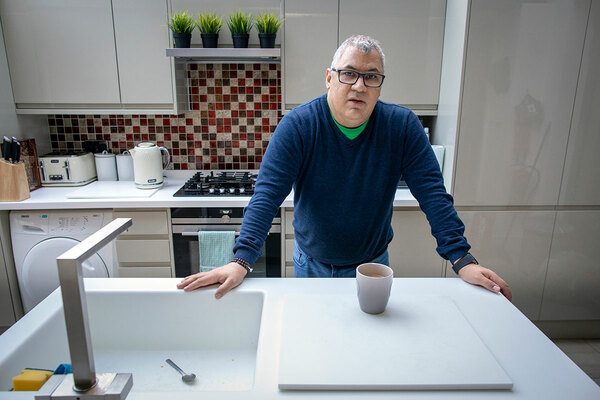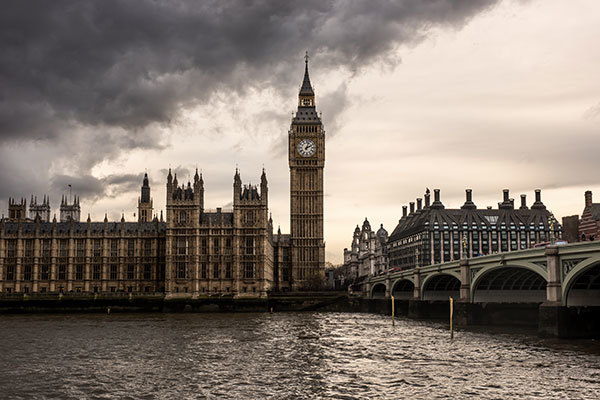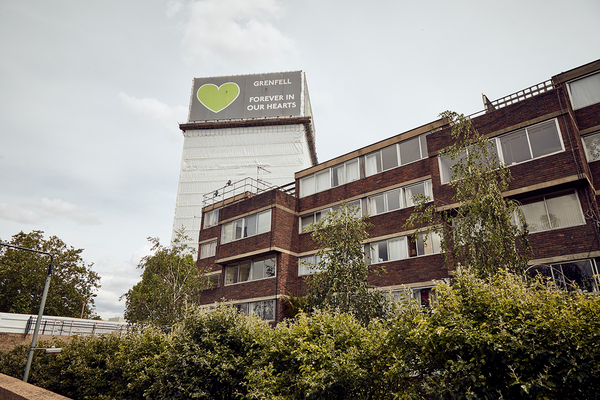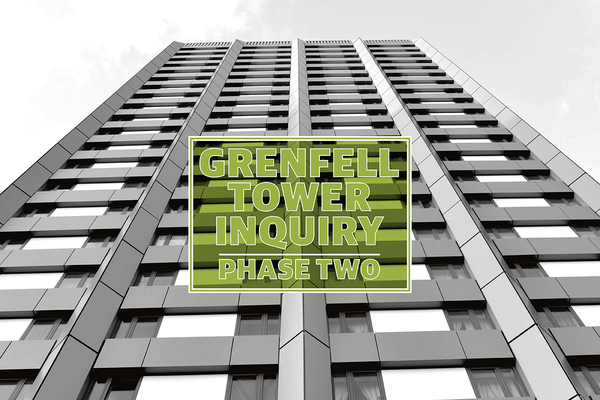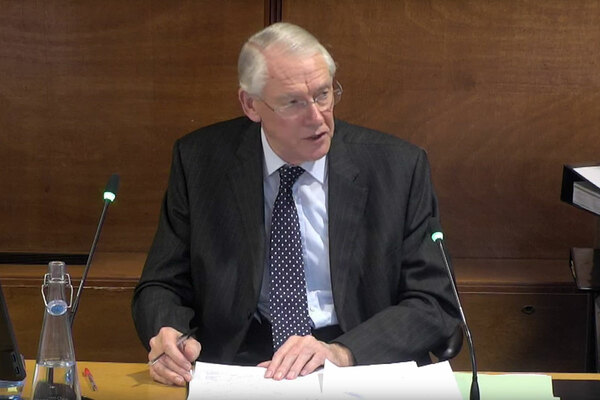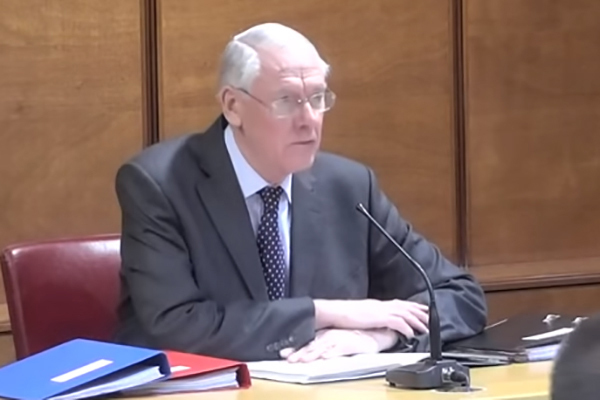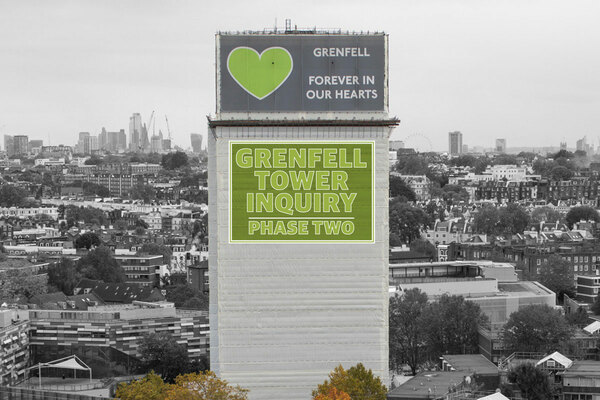Grenfell Tower Inquiry diary week one: a vivid picture of a broken industry
After a week of damning revelations at the opening of phase two of the Grenfell Tower Inquiry, Peter Apps recaps the key points
The Grenfell Tower Inquiry’s second phase began this week with a series of shocking revelations about both the knowledge key players had of the danger of the cladding system and the apparent complacency about the safety of the tower’s residents.
With each of the corporate core participants in the messy web of companies responsible for the refurbishment attempting to absolve themselves of blame, they turned on one another – reeling off a succession of damning emails, internal documents and allegations of malpractice.
Have scribbled this out for our art editor to attempt to put into print tomorrow.
— Peter Apps (@PeteApps)
The web of companies + organisations involved in the Grenfell Tower refurbishment pic.twitter.com/VxIEHojfJvHave scribbled this out for our art editor to attempt to put into print tomorrow.
— Peter Apps (@PeteApps) January 28, 2020
The web of companies + organisations involved in the Grenfell Tower refurbishment pic.twitter.com/VxIEHojfJv
One defence put forward on behalf of some of these corporates was that there was nothing unusual about this cladding system – the materials are used on hundreds of high rises around the country.
This is true, but perhaps only goes to show that some of the shocking issues we have seen exposed this week are in fact relatively common in the industry.
A plea for immunity
The shock moment of the week came on Wednesday morning when – after two days of damning revelations – a group of corporates, including Kensington and Chelsea Tenant Management Organisation, sought a guarantee from the Attorney General that the evidence they give would not be used to further a criminal prosecution against them.
This was widely misreported as a plea for immunity full stop, but it never was. Instead it would serve as a prohibition on the specific answers forming part of the crown’s case should these issues ever see the light of a criminal court.
There was a sense of hijacking the process (this could have been raised and dealt with many months ago) as well as holding it to ransom (there was an implicit threat that answers would be limited if the guarantee was not given).
Audible shock and anger from the survivors present was not surprising, given everything they had been through to this point and the callousness of the attitudes the evidence had already exposed. So what was this evidence? Below are short summaries of some of the key points.
The contractors and architects
Opening statements for architects Studio E, main contractor Rydon and cladding specialist Harley were given on Monday.
They focused on a criticism of the government’s regulations, which were described as “not fit for purpose”, as well as attacking the manufacturers of the cladding and insulation for making their products appear safe. The consistent theme was that they simply did not know that the very widely used products they were working with were dangerous.
This claim came under severe strain on Tuesday, however, when the counsel for insulation manufacturer Celotex unveiled an email chain from 2015 relating to a requirement to install fire barriers in the cladding system. There was general agreement that there was no point doing so because in a fire the cladding would “fail” regardless of any barriers.
“There is no point in ‘fire stopping’, as we all know; the ACM will be gone rather quickly in a fire! The whole point [of barriers] is to stop ‘unseen’ fire spreading in the cavity,” wrote Daniel Anketell-Jones of Harley.
They may argue when called to give evidence that the belief expressed here was that the aluminium composite material (ACM) would burn and fall off the building rather than rip up and around it, but it still shows they were well aware that the products they were dealing with carried a fire risk.
More broadly, the accusation is that none of these parties thought particularly hard, if at all, about whether the cladding complied with building guidance.
It did not meet any of the four routes to compliance available through industry guidance – thanks to having combustible insulation, no large-scale test data, no desktop study and no final sign-off from a fire engineer.
A requirement that all components of the cladding system be of ‘limited combustibility’ was also specifically incorporated into Rydon’s contract. But instead, materials of a much lower standard were used. Each of the key members of the design team – Rydon, Harley and Studio E – pointed fingers at each other for where the blame for this major error lay.
The manufacturers
Both Arconic (which made the cladding panels) and Celotex (which made the insulation) have also come in for heavy criticism.
Giving their opening statements on Tuesday, they ran slightly different versions of the same argument: all we did was sell the product, and it was up to those who designed the cladding system to ensure it was safe and compliant.
But these arguments appear to have been severely undermined by other revelations this week.
First Arconic. On Monday, emails were read out revealing that the manufacturer was well aware that its panels were testing below the standard they were advertised as and were potentially dangerous during a fire – particularly in their ‘cassette’ form.
“The classification obtained for the Reynobond PE cassettes is the same as that of competitors, ie ‘F’ [they were marketed with a certificate that suggested they were Class B], and therefore not suitable for use on building façades,” senior member of staff Claude Wehrle wrote in 2011.
Rather than simply sell the panels, lawyers for the survivors have pointed to evidence that Arconic specifically targeted the Grenfell Tower project from as early as 2012.
Other emails have shown that Arconic at least believed it had knowledge of where its products were used. In 2013, the BBC ran a report about a fire comprising ACM cladding in the UAE, and UK sales manager Deborah French sent a note saying the company was able to “follow what type of project is being designed developed and offer the right Reynobond specification including the core”.
For Celotex, the firm had managed to get its insulation through a test in May 2014 that would have made its use on high rises compliant with the regulations, if combined with non-combustible cement fibre cladding.
It claims that it is not to blame for the designers not sticking to this specification and using highly combustible ACM instead.
But its own marketing – which described the insulation as “acceptable for use above 18m” – was said to have been designed to exploit confusion about the building guidance by lawyers for the survivors.
It also aggressively marketed to Grenfell Tower, including the tower on a “must-win” projects list in 2014 and hoping to include it as a “flagship” project for its RS5000 insulation in future marketing, it was claimed.
The fire engineers
Exova, a major fire engineering consultancy, described by one of the inquiry’s experts as “top tier”, produced three reports on the Grenfell Tower refurbishment, the last in November 2013.
Each of these reports contained a statement that “the proposed changes will have no effect on the building in relation to external fire spread, but this will be confirmed by an analysis in a future issue of this report”.
The firm’s explanation is that this is before the final cladding system was defined, and they were never invited back to complete the final report, with Rydon electing not to use a fire engineer.
However, lawyers for the survivors and bereaved challenged this claim, pointing out that a cladding system of some sort had been proposed and should have been considered. “What should have been said was that the cladding would likely have an adverse effect, but the extent of the worsening of condition could not be known until the precise cladding system had been defined,” said Stephanie Barwise QC. She said that this claim gave “a false sense of security” to the design team and described it as “a negligent misstatement” that was “likely to be causative” in regard to the fire.
In a withering attack on Exova, she said that the firm saw its role as “playing down potential non-compliance in order to get around the building control officer”.
Cost cutting and aesthetics
There has been much discussion of so-called value engineering this week – the process of swapping one product for another, cheaper alternative in order to reduce costs.
It seems beyond doubt that it was this that led to the former zinc cladding being switched out for the deadly polyethylene-cored ACM.
It was said that in 2013, the project was “realigned” by the Royal Borough of Kensington and Chelsea (RBKC) to make “value for money” the “primary driver”. This resulted in the creation of a “value engineering hitlist” in December 2013.
Moreover, lawyers for the survivors claim that while a new contractor was being procured, KCTMO made a secret approach to Rydon – which eventually won the bid – asking it to reduce its quote by £800,000, including a £234,000 reduction by switching the zinc cladding for an alternative.
There were also claims that the decision on the insulation routed back to a desire to win environmental funding by exceeding the requirements for thermal insulation set in building guidance. To do this within the design required the use of combustible plastic insulation.
The project was also dogged by a focus on aesthetics. This has been well known since days after the fire, but new allegations were also made this week.
These include that architects Studio E “agonised” between “the brushed aluminium and the battleship grey” colour and therefore ignored fire safety almost completely. It was also suggested that with the construction of a new school next door, also designed by Studio E, Grenfell would become an “eyesore” and “poor frontage” for the new project – with cladding seen as the solution.
Building control
The only party to admit serious fault in the opening statements was RBKC, which acknowledged “serious failings” on the part of its building control team.
This was something it arguably had little choice in. With the project found to be in breach of the regulations, it is essentially already accepted as a matter of fact by the inquiry that building control failed.
What we learned, though, was the extent of this failure. Building control officers at the council did not seek to find out the details of the cladding system, did not identify the insulation as combustible and did not request an up-to-date version of the fire strategy.
This looks less like an accidental misunderstanding of potentially confusing guidance and more a total failure to apply the rules at all.
What’s next?
Monday will be given over to submissions from lawyers acting for the bereaved and survivors on the above issue of immunity, as well as submissions from the inquiry’s own lawyer on the same point.
Tuesday will be given over to the same issue and if oral evidence begins next week at all it will be on Wednesday, with witnesses from Studio E the first supposed to attend.
Grenfell Tower Inquiry news stories: week one
Corporations accused of merry-go-round of buck passing as inquiry opens
The corporations involved in the doomed refurbishment of Grenfell Tower have been accused of a “merry-go-round of buck passing”.
Grenfell cladding manufacturer aware panels were dangerous and below standard, inquiry hears
The manufacturer of the cladding panels used on Grenfell Tower was aware they had a low fire rating that made them “dangerous” for use on tall buildings, the inquiry into the fire heard.
Designers and contractors knew Grenfell cladding system would 'fail' in a fire
The contractors, architects and fire safety consultants working on the Grenfell Tower refurbishment exchanged emails acknowledging that the new cladding system would fail in a fire, with one writing “as we all know, the [aluminium composite material] will be gone rather quickly” in 2015, the inquiry heard.
RBKC building control officers failed to request basic details of Grenfell cladding system
Building control officers at the Royal Borough of Kensington and Chelsea (RBKC) failed to request basic details about the cladding system installed on Grenfell Tower before signing it off, the council has admitted.
KCTMO 'not a passive bystander' in refurbishment, inquiry hears
Kensington and Chelsea Tenant Management Organisation (KCTMO) was not a “passive bystander” in the Grenfell Tower refurbishment and took on key roles including a drive for cost-cutting, a consultant to the project has claimed.
The government is likely to have breached the Human Rights Act over its failure to overhaul buildings regulations in the years before the Grenfell Tower fire, the inquiry into the tragedy has heard.
The organisations involved in the refurbishment of Grenfell Tower
Picture: Jon Enoch
KCTMO: Kensington and Chelsea Tenant Management Organisation, the arm’s length management organisation responsible for providing housing management to Grenfell Tower. It was the end client which procured the refurbishment and oversaw it.
Rydon: Main contractor. It won a tender for the ‘design and build’ of the refurbishment project in March 2014, with a contract signed in October. It then held overall responsibility for the work, sub-contracting various elements to more specialist firms.
Celotex: The manufacturer of the RS5000 insulation which formed the majority of the insulation on the tower. The product is made from a combustible plastic called RS5000.
Arconic: A large multinational aluminium company, which manufactured and sold the Reynobond PE 55 cladding panels which were installed on the tower.
RBKC: As well as ultimately owning the tower, the Royal Borough of Kensington and Chelsea provided the ‘building control’ function for the refurbishment. This involved providing a completion certificate which effectively signed off the project as compliant with building regulations.
Studio E: Architect – first engaged by KCTMO as the principal designer for the wider refurbishment, it became a sub-contractor following Rydon’s appointment in 2014, working under the standard RIBA terms of business.
Harley: Specialist sub-contractor for the cladding. It was in contract with Studio E before Rydon was appointed, and then struck an agreement with Rydon for the design of the facade works.
Exova Warringtonfire: Fire engineer. Appointed by KCTMO in mid-2012 to provide a fire strategy for the building as it stood and for the refurbishment work. Three versions of the refurbishment version were produced, the last in November 2013. It provided ongoing advice after this point but was not directly engaged by Rydon.
CEP: The fabricator, responsible for cutting the panels into cassettes. CEP was one of a small number of ‘approved’ fabricators which worked closely with Arconic. Also supplied the window frames.
Max Fordham: The engineering consultant which worked for the TMO providing advice on energy strategy and sustainability. It was Max Fordham that identified Celotex insulation as a product which could meet the target insulation performance and was also thin enough to fit the design dimensions.
Kingspan: Produced and sold a smaller amount of combustible K15 insulation which was used on the tower.
Siderise: Produced and sold the cavity barriers.
Aluglaze: Produced and sold the window panels.
Artelia: The construction, design and management co-ordinator, employer’s agent and quantity surveyor, assisting KCTMO with its management of the contract.
Osborne Berry: The building contractor appointed by Harley to fit the cladding and window systems.
Kevin Lamb: An independently outsourced specialist cladding designer which provided Harley with detailed design drawings.
John Rowan and Partners: The clerk of works reporting to the TMO, responsible for site inspection and monitoring.
SD Plastering: A sub-contractor responsible for fitting the window surrounds.
JS Wright: A mechanical and electrical sub-contractor. It will have little involvement in module one.
Curtins Consulting: A structural engineer reporting first to KCTMO and then to Rydon. They will also have little involvement in module one.
Grenfell Tower Inquiry: phase two timeline
Sir Martin Moore-Bick, the retired judge who chairs the inquiry (picture: Grenfell Tower Inquiry)
The inquiry will be spread across eight modules, with the below timeline set out at the start of the inquiry:
Module one: 27 January to April 2020
Module one will examine the role, acts and omissions of the professionals involved in the refurbishment of the tower from 2012 to its sign-off on 20 July 2016.
Module two: 4 May to mid-June 2020
This section will examine the testing, classification, certification and marketing of key products used in the external wall, particularly the Reynobond PE 55 cladding panels and the polyisocyanurate insulation made by Celotex.
Module three: June to early October 2020
This will involve three topics: first, the complaints made by residents, particularly those relating to fire safety and the quality of the workmanship; second, the compliance with the requirements of the Regulatory Reform Order 2005 by the council, Kensington and Chelsea Tenant Management Organisation and the London Fire Brigade; and finally, active and passive safety measures in the tower. Closing statements for all the first three modules will then follow.
Module four: mid-October to mid-November 2020
This module will assess the performance of local and national government in the immediate aftermath of the fire.
Module five: mid-November 2020 to mid-February 2021
The firefighting operation will be reviewed in more detail in this section, including an analysis of training and the suitability of equipment.
Module six: February 2021 to May 2021
This module will turn the lens on central government, with a focus on the responses to previous incidents and
reports, coroners’ recommendations and things of that nature – including in respect of the building regulations and associated guidance, as well as fires and firefighting.
Module seven: May 2021
One week has been set aside for an assessment of the remaining expert evidence.
Module eight: timetable to be announced
This will assess any remaining evidence, including an attempt to establish how each of the deceased met their deaths. The bereaved and survivors have been invited to make submissions about other matters, which should be considered in this module.
Grenfell Tower Inquiry phase two previews
Picture: Getty
Inside Housing published a series of preview articles ahead of the start of Phase Two of the Grenfell Tower Inquiry on Monday 27 January. You can read them here:
What was known in central government about cladding?
What did officials know about the dangers of fire from combustible cladding, and did they act on the warnings?
Click here to read the full story
The testing and certification of materials
What tests and certificates existed for the materials used in the cladding system on Grenfell Tower, and was the system that provided them fit for purpose?
Click here to read the full story
The decision to install the cladding
Who decided to install polyethylene-cored ACM cladding on Grenfell Tower and why?
Click here to read the full story
The fire doors and windows
What went wrong with the fire doors and window installed at the tower?
Click here to read the full story
The warnings of the local community
What did residents say before the fire and why were they ignored?
Click here to read the full story
Over the course of the inquiry, Inside Housing will publish regular news updates on its progress and a weekly round-up of the key evidence and its significance for the social housing sector every Friday afternoon.

